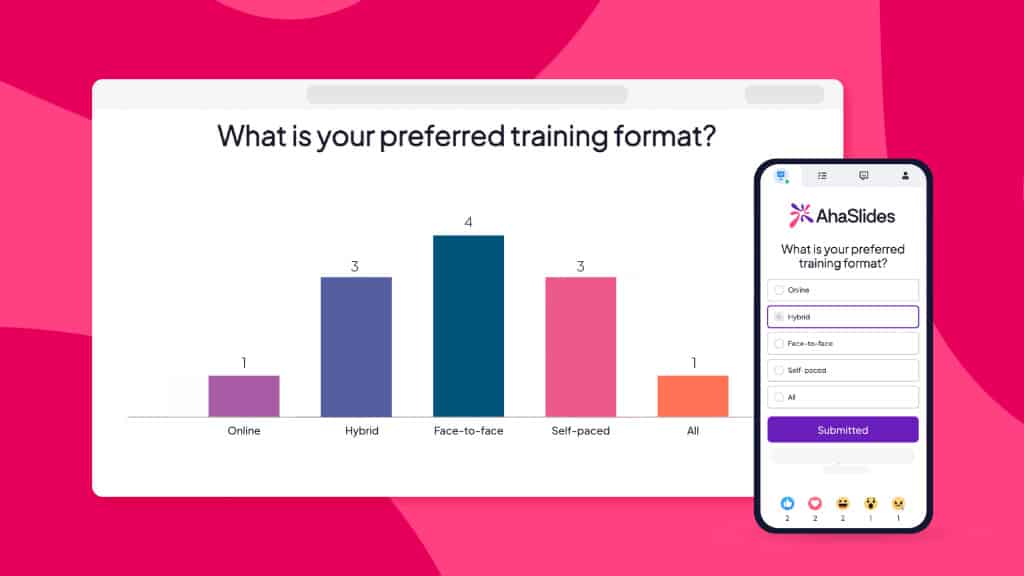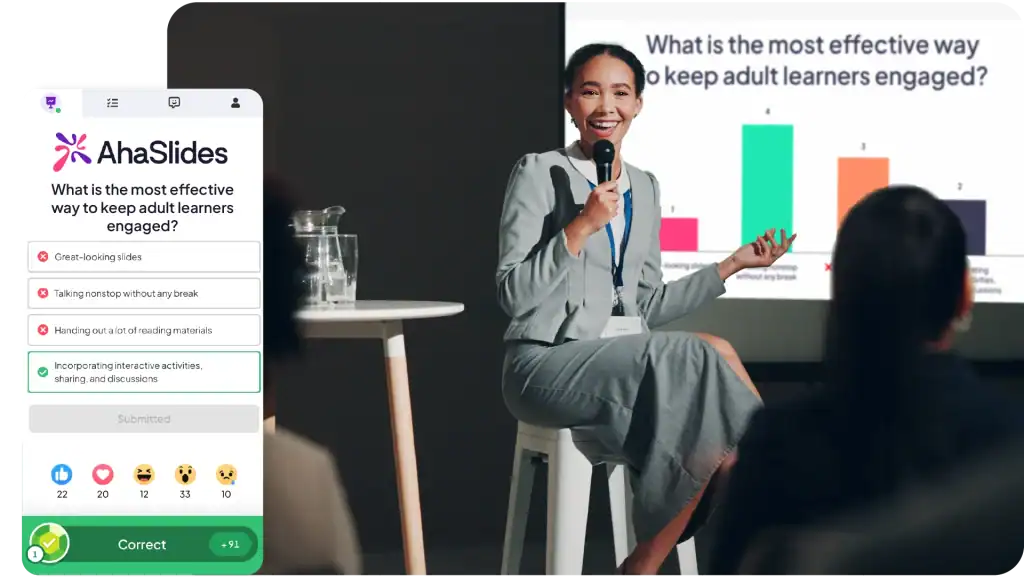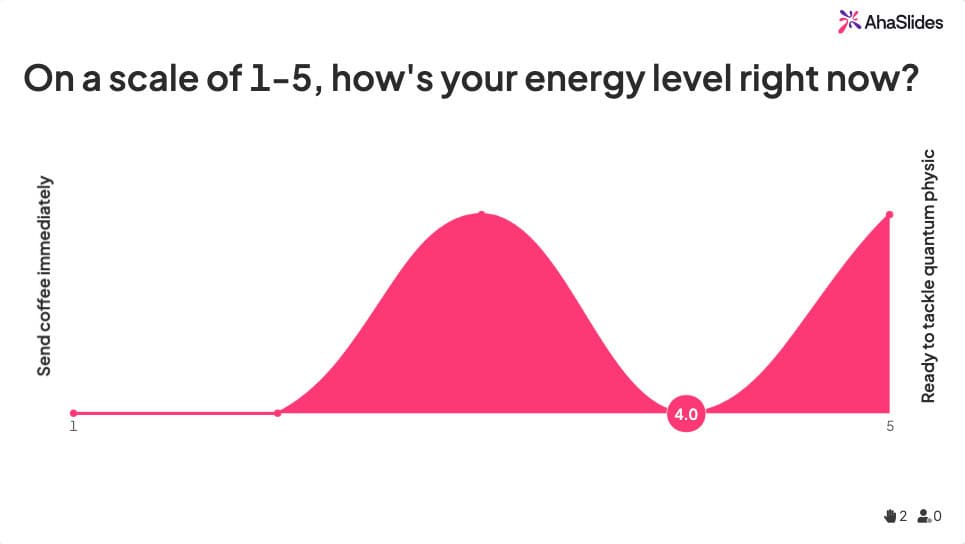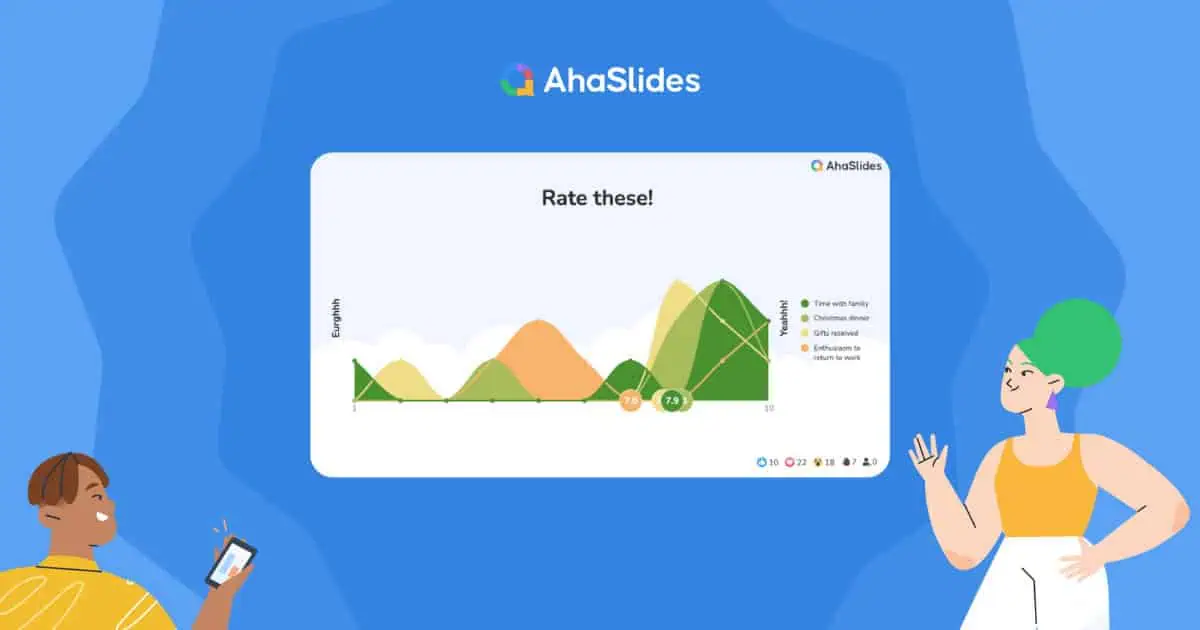Dina ékonomi perhatian anu dilatih TikTok ayeuna, anjeun gaduh sakitar 8 detik pikeun ngarebut minat batur — kirang waktos tibatan lauk mas. Upami éta pikasieuneun pikeun presentasi 5 menit, ieu mangrupikeun warta anu saé: presentasi pondok mangrupikeun senjata rahasia anjeun.
Bari batur ramble ngaliwatan 60-slide decks ningali panon glaze leuwih, anjeun bakal nganteurkeun pesen fokus nu nempel. Naha anjeun nuju pitching ka investor, ngalatih tim jauh, presenting papanggihan panalungtikan, atawa ngawawancara pikeun peran impian anjeun, mastering format 5-menit teu ngan merenah-éta karir-defining.
Pituduh ieu ngagambar élmu presentasi, wawasan ti palatih profésional anu nganteurkeun ratusan sesi taunan, sareng téknik anu kabuktian ti panyatur TED pikeun ngabantosan anjeun ngadamel presentasi anu kalibet, ngayakinkeun, sareng masihan dampak anu langgeng.
Daptar eusi
Naha 5-Menit Presentasi Menta Pendekatan anu Béda
panalungtikan ti neuroscientist John Medina nunjukeun yen perhatian panongton pakait nyata unggal 10 menit salila presentasi tradisional. Dina setélan virtual, jandela éta ngaleutikan ukur 4 menit. Presentasi 5-menit anjeun leres-leres dina tempat pertunangan ieu-tapi ngan upami anjeun ngarancangna leres.
Patokna langkung luhur kalayan presentasi pondok. Unggal kecap diitung. Unggal slide penting. Teu aya waktos kanggo pangisi, teu aya rohangan pikeun tangents, sareng nol toleransi pikeun fumbles téknis. Panaliti industri nunjukkeun yén 67% profésional ayeuna langkung milih presentasi anu singket, fokus tibatan anu panjang-tapi seuseueurna presenter masih ngadeukeutan ceramah pondok salaku vérsi anu pondok tina anu panjang, anu jarang dianggo.
Kumaha Jieun Presentasi 5 Menit
Lengkah 1: Pilih Topik Anjeun Kalayan Precision Bedah

Kasalahan pangbadagna anu dilakukeun ku presenter? Nyobian nutupan taneuh teuing. presentasi 5-menit anjeun kedah alamat hiji gagasan inti— moal tilu, moal dua. Pikirkeun éta salaku laser, sanés lampu sorot.
Topik anjeun kedah lulus tés opat bagian ieu:
- Titik fokus tunggal: Naha anjeun tiasa ngajelaskeun dina hiji kalimat? Lamun henteu, sempit eta handap.
- relevansi panongton: Naha éta ngarengsekeun masalah anu nuju aktip disanghareupan? Skip informasi aranjeunna geus nyaho.
- kesederhanaan: Dupi anjeun ngajelaskeun eta tanpa latar tukang kompléks? Simpen topik anu rumit pikeun format anu langkung panjang.
- Kaahlian anjeun: Lengket subjék anjeun terang deeply. Waktu persiapan diwatesan.
Pikeun inspirasi, pertimbangkeun topik 5 menit anu kabuktian dina konteks anu béda:
- Setélan profésional: 3 strategi anu didorong ku data pikeun ngirangan churn palanggan, Kumaha alat AI ngarobih deui alur kerja urang, Naha hasil Q3 kami nunjukkeun pangsi strategis
- Pelatihan & L&D: Hiji kabiasaan anu transforms kinerja tim jauh, The psikologi balik skor Dursasana pagawe, Kumaha méré eupan balik nu sabenerna ngaronjatkeun kabiasaan
- Konteks akademik: Papanggihan konci tina panalungtikan kelestarian kuring, Kumaha média sosial mangaruhan kaputusan rumaja, Étika ngedit gén dina tilu skenario nyata.
Lengkah 2: Desain Slides Anu Ngagedékeun (Henteu Ngaganggu)
Ieu bebeneran anu misahkeun amatir ti presenter profésional: anjeun presentasi, teu slides Anjeun. Slides kedah ngarojong naratif anjeun, teu ngaganti eta.
Patarosan cacah slide
Panalungtikan ti ahli presentasi nyarankeun 5-7 slides pikeun 5-menit ngobrol-kasarna hiji slide per menit kalawan waktu pikeun muka jeung nutup Anjeun. Nanging, panyatur TED kadang nganggo 20 slide anu maju gancang (masing-masing 10-15 detik) pikeun ngajaga moméntum visual. Anu langkung penting tibatan kuantitas nyaéta kajelasan sareng tujuan.
Prinsip desain eusi
- Teks minimal: Maksimum 6 kecap per slide. Naskah 700 kecap anjeun kedah diucapkeun, henteu ditampilkeun.
- Hierarki visual: Anggo ukuran, warna, sareng rohangan bodas pikeun nungtun perhatian kana naon anu paling penting.
- Visualisasi data: Hiji statistik compelling atawa grafik per slide ngéléhkeun paragraf katerangan.
- Desain konsisten: Fon, warna, sareng tata letak anu sami sapanjang ngajaga profesionalisme.
Pro tip: Jieun presentasi anjeun interaktif nganggo polling langsung, fitur Q&A, atanapi kuis gancang. Ieu transforms pemirsa pasip kana pamilon aktip tur nyirorot ngaronjatkeun ingetan informasi. Alat sapertos AhaSlides ngidinan Anjeun embed fitur ieu seamlessly, sanajan dina format 5-menit.

Lengkah 3: Ngawasaan Timing Jeung Precision Militér
Dina presentasi 5 menit, unggal detik ngagaduhan padamelan. Henteu aya panyangga pikeun rambling atanapi pulih tina kasalahan. Panyatur profésional nuturkeun struktur anu diuji perang ieu:
Rumus alokasi waktos anu kabuktian
- 0:00-0:30 - Kait bubuka: Tarik perhatian ku kanyataan anu ngareureuwas, patarosan provokatif, atanapi carita anu pikaresepeun. Skip perkenalan panjang.
- 0:30-1:30 - Masalahna: Ngadegkeun naha panongton Anjeun kedah paduli. Naon tantangan anu ditujukeun ku topik anjeun?
- 1:30-4:30 - Solusi / wawasan anjeun: Ieu eusi inti Anjeun. Nepikeun 2-3 titik konci kalayan bukti anu ngadukung. Motong nanaon non-ésénsial.
- 4:30-5:00 - Kacindekan & ajakan-ka-aksi: Nguatkeun pesen utama anjeun sareng nyarioskeun ka pamiarsa naon anu kedah dilakukeun salajengna.
adjustment presentasi virtual
Nampilkeun jarak jauh? Ngawangun momen papacangan unggal 4 menit (per panalungtikan Madinah). Anggo polling, naroskeun réspon obrolan, atanapi pasang patarosan rétoris. Pariksa sudut kaméra anjeun (tingkat panon), mastikeun cahaya kuat ti hareup, sarta nguji kualitas audio sateuacanna. Pamirsa virtual langkung rentan ka selingan, janten interaksi henteu opsional-penting pisan.

Lengkah 4: Nganteurkeun Jeung Kayakinan Otentik

Malah eusi cemerlang ragrag datar kalawan pangiriman goréng. Ieu kumaha para profesional ngadeukeutan momen bebeneran:
Prakték sapertos karir anjeun gumantung kana éta (sabab éta tiasa)
Latihan presentasi 5 menit anjeun sahenteuna 5-7 kali. Paké timer a. Rekam diri anjeun sareng nonton deui-nyeri tapi teu ternilai. Praktek dugi ka tiasa nganteurkeun eusi anjeun sacara alami tanpa maca slide. Mémori otot mawa anjeun ngaliwatan nervousness.
Téhnik pangiriman anu misahkeun amatir ti pro
- Ragam vokal: Beda laju, nada, sareng volume. Ngareureuhkeun strategis pikeun tekenan - tiiseun kuat.
- Basa awak: Di-jalma, make sapuan kabuka sarta mindahkeun kalawan tujuan. Dina kaméra, wates sapuan (aranjeunna ngagedékeun) sareng mertahankeun kontak panon sareng lensa.
- Storytelling: Ninun dina ringkes, conto relevan atawa anekdot. Carita naekeun ingetan ku 22x dibandingkeun sareng fakta nyalira.
- Manajemén énergi: Cocogkeun énergi anjeun sareng pesen anjeun. Antusias pikeun inspirasi, diukur pikeun topik anu serius.
- kesiapan teknis: Alat uji 30 menit awal. Boga rencana cadangan pikeun masalah konektipitas.
Rahasia sambungan panongton
Pikirkeun presentasi anjeun salaku paguneman, sanés pagelaran. Pertahankeun kontak panon (atanapi tingali kaméra pikeun presentasi virtual). Ngaku réaksi. Upami anjeun titajong, ngareureuhkeun sakeudeung sareng teraskeun — pamirsa ngahampura kaaslianana, tapi henteu maca slide sacara robotik.
Tip rusiah: Henteu terang upami presentasi 5 menit anjeun gaduh pangaruh? Paké a alat eupan balik pikeun ngumpulkeun sentimen panongton urang langsung. Butuh usaha minimal, jeung anjeun ulah leungit eupan balik berharga sapanjang jalan.

5 Kasalahan Umum Nalika Méré presentasi 5 Menit
Kami nungkulan sareng adaptasi ngaliwatan trial and error, tapi langkung gampang pikeun nyingkahan kasalahan rookie upami anjeun terang naon éta👇
- Ngajalankeun kana waktu: Pamirsa bewara. Ieu sinyal persiapan goréng jeung disrespects jadwal maranéhanana. Latihan nepi ka rengse di 4:45.
- Overloading slides: slides téks-beurat nyieun audiences maca tinimbang ngadangukeun. Anjeun leungit perhatian maranéhanana instan.
- Latihan ngaluncat: "Éta ngan 5 menit" nyaéta pamikiran bahaya. Format pondok nungtut MORE prakték, teu kurang.
- Nyobian nutupan sadayana: Jero ngéléhkeun rubakna. Hiji wawasan anu jelas anu resonates langkung saé tibatan lima poin anu teu aya anu émut.
- Teu malire panongton anjeun: Sesuaikeun eusi pikeun kapentingan, tingkat pangaweruh, sareng kabutuhan. presentasi generik pernah darat.
5-Conto Presentasi Menit
Diajar conto ieu ningali prinsip dina aksi:
William Kamkwamba: 'Kumaha Kuring Harnessed Angin'
ieu TED Talk video presents carita William Kamkwamba, hiji panemu ti Malawi anu, salaku nak ngalaman kamiskinan, ngawangun kincir angin pikeun ngompa cai jeung ngahasilkeun listrik pikeun désana. Carita Kamkwamba anu alami sareng lugas tiasa narik perhatian pamiarsa, sareng panggunaan jeda pondok pikeun jalma seuri ogé mangrupikeun téknik anu saé.
Susan V. Fisk: 'Pentingna Singket'
ieu video latihan nawarkeun tips mantuan pikeun élmuwan struktur ceramah maranéhanana pikeun nyocogkeun ka format presentasi "5 Menit Rapid", nu ogé dipedar dina 5 menit. Upami anjeun badé ngadamel presentasi gancang "Kumaha-cara", tingali conto ieu.
Jonathan Bell: 'Kumaha Nyieun Ngaran Brand Great'
Salaku judulna nunjukkeun, spiker Jonathan Bell bakal masihan anjeun a pituduh léngkah-léngkah dina cara nyieun ngaran merk langgeng. Anjeunna langsung ka titik sareng topikna teras ngabagi kana komponén anu langkung alit. Hiji conto alus pikeun diajar ti.
Invoice PACE: '5 Min Pitch di Startupbootcamp'
Video ieu nunjukkeun kumaha Invoice PACE, a ngamimitian specializing dina ngolah pembayaran multi-mata uang, éta bisa pitch gagasan -na pikeun investor jelas tur concisely.
Will Stephen: 'Kumaha Sora Smart dina Obrolan TEDx Anjeun'
Ngagunakeun pendekatan humoris tur kreatif, Will Stephen urang TEDx Talk nungtun jalma ngaliwatan kaahlian umum diomongkeun publik. Wajib-nonton pikeun ngadamel presentasi anjeun janten karya agung.
Siap nyieun presentasi anu sabenerna kalibet? Mimitian ku alat presentasi interaktif AhaSlides sareng transformasi presentasi 5-menit salajengna anjeun tina anu tiasa dipohokeun ka anu teu tiasa hilap.








